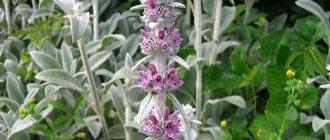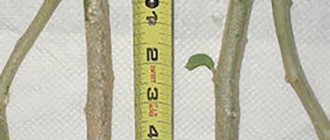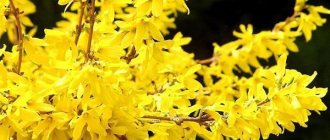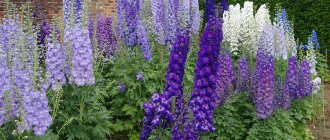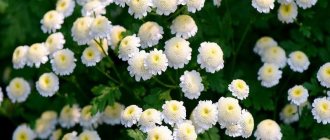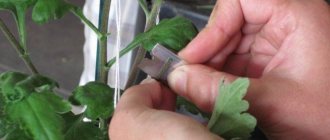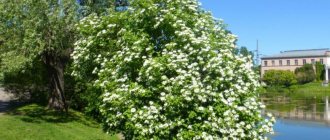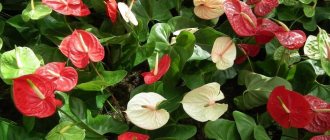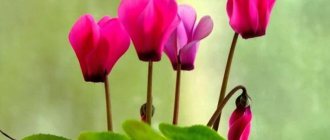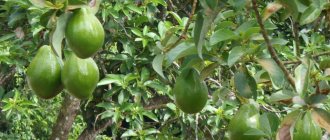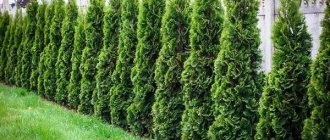Author: Elena N. https://floristics.info/ru/index.php?option=com_contact&view=contact&id=19 Category: Garden plants Published: February 19, 2019Last edits: November 04, 2020
- Growing conditions
- Woolly chick (Stachys lanata)
Chistets (lat. Stachys), or stachys , is a genus of subshrubs or herbaceous perennials and annuals of the Lamiaceae family. “Stakhis” means “spike”: this is what the inflorescences of chistets look like. The homeland of stachys is Asia Minor and the Balkans, from where it spread throughout Europe and Asia and eventually became a cultivated plant. There are more than 300 species in the genus, growing today everywhere except New Zealand and Australia. Chest is grown as an ornamental and medicinal plant.
Planting and caring for chistets
- Flowering: about 4 weeks in August.
- Planting: sowing seeds for seedlings in early March, planting seedlings in open ground in the second half of May.
- Lighting: bright light or partial shade.
- Soil: moisture-absorbing sandy and rocky soils of alkaline and neutral reaction.
- Watering: regular, but moderate: water the plant only in dry seasons; in normal weather, natural precipitation is sufficient.
- Feeding: twice a season with rotted compost.
- Hilling: at the very beginning of flowering.
- Reproduction: seeds, cuttings, tubers and dividing the bush.
- Pests and diseases: the plant is very resistant.
Read more about growing chistets below.
Biological features of stachys
Chistets are distributed on all continents except Australia. There are more than 300 species. About 50 varieties grow in different regions of Russia.
The height is about 1 meter, a characteristic feature is pubescent leaves. There are different shapes - heart-shaped, jagged, oval.
In Latin, "stachys" means "spike". Stachys inflorescences are collected in a spike. The flowers are small, bell-shaped, pink, purple, lilac, lilac, yellow and white.
Flowering from May to August. The fruits are nut-shaped.
Growing chistema from seeds
When to plant
Chest grass propagates by seeds, tubers, cuttings and division of the bush. Chistets seeds have a high germination rate. They are sown in seedling substrate at the end of winter or early spring. The crops are watered, covered with film and placed in a warm place. Shoots appear within a month, and after the seedlings have formed the first pair of leaves, they are picked.
How to plant
In the second half of May, when the threat of return frosts has passed, the seeds are planted in open ground. The best place for it is a sunny area or partial shade, and the plant is undemanding to the composition of the soil: it grows well on sandy and rocky soils of a neutral or alkaline reaction. The only prerequisite is high soil moisture capacity.
- How to grow morning glory seedlings: sowing and picking
The holes are placed at a distance of 15-20 cm from each other, drainage material is placed at the bottom of each of them - pebbles, pebbles or coarse sand, which is sprinkled with a layer of soil with humus on top. Then the seedlings, together with a lump of earth, are transferred into the holes, and after planting, they are watered abundantly.
Characteristics of the plant and its use in landscape design
Chistets Byzantine, stachys or, as it is also called, sheep's or hare's ears, is a charming plant, practically undemanding to care, with dense pubescence of leaf plates
In the wild, it is distributed throughout Eurasia, Africa and America, belongs to the Yamnotaceae family, and at the time of flowering it emits a light pleasant aroma, attracting the attention of beneficial pollinating insects
For landscape design specialists, the decorative nature of the fluffy plant makes it possible to use it to implement various ideas. Chistets are planted as a border, since its short growth allows it to be cut without cutting the flower stalks in a timely manner. Dense planting of silvery foliage looks impressive framed in flower beds and garden paths.
The plant also fits perfectly into rock gardens, rocky gardens and alpine hills. In combination with stone compositions, “bunny ears” become the highlight of the design idea, attract the eye, and create a desire to touch the foliage. It's all about the contrast between the hard natural material and the pubescence of the plant.
A winning accent for planting chisteta can be among perennial or annual flowers. The unusual texture and cold steel color will be an excellent complement to the bright colors of the flowerbed. The main thing is to make sure that the neighbors in the composition are not too demanding about the presence of large amounts of nutrients in the soil. On fertile soil, the green of the “ears” becomes brighter, and then they lose their natural charm.
Various combined compositions of chistets with decorative foliage plants, such as hostas and milkweed, leave endless scope for ideas. Such plantings may be appropriate both at an artificial pond and at the foot of a rock garden.
Caring for chickweed in the garden
Growing conditions
Planting and caring for chistets is not labor-intensive. You will need to regularly water the plant, remove weeds around it and loosen the soil, and spud it up at the very beginning of flowering.
Watering should be moderate: moisture should not be allowed to stagnate in the roots, so the plant is watered only during dry periods, otherwise the chickweed may shed its leaves.
The plant is fertilized with rotted compost, which is applied to the soil once a season.
Growing chickweed requires pruning shoots that spread beyond the site, otherwise the plant may take over territories not intended for it. Keep in mind that the weed will be difficult to remove because it self-seeds easily. To prevent seeds from spilling onto the ground and germinating uncontrollably, trim the flower stems during the period of bud formation. It is also necessary to remove nondescript inflorescences because they reduce the decorative effect of the flowerbed.
In one place, chistets flowers can grow for several years, but over time, a void forms in the middle of the rosette, so once every 3-4 years, young chistets rosettes are planted in the center of the bush.
- How to plant and care for clematis
Pests and diseases
The chickweed is extremely rarely affected by pests and diseases.
Chistets after flowering
The perennial chistet tolerates cold well and requires shelter only in very cold and snowless winters: to protect it from frost, it is covered with spruce branches. But even if the chickweed survives the cold winter normally, it may die in the spring from waterlogging if its roots remain in melt water for a long time. Keep this in mind when choosing a place for stakhis.
Usage
Chistets Byzantine is most often used in landscape design. Stachys in combination with other plants create unique compositions that decorate the garden. Designers like to use chistets on alpine slides, rockeries, and borders:
- A good combination with a yoke and a two-color cross;
- Looks good in tandem with stones;
- Compositions of stachys with Carpathian bells, speedwells, lavender and ageratum are distinguished by their elegance;
- Looks beautiful with marigolds;
- Hostas and heucheras look very original next to chistets;
- Used in winter bouquets.
If you want to grow a beautiful and unusual plant in your garden, you can safely plant woolly chist. It looks aesthetically pleasing, pleasant to the touch and does not require special growing conditions.
The flower is considered very unpretentious and does not require special care. Taking care of it is as easy as shelling pears.
It is best to plant Chistets Byzantine in a sunny or partial shade location. The main rule is that the more sun there is, the silverier its leaves will become. The chist prefers soil that is light, loose, not enriched with nitrogen, and has an alkaline or neutral reaction. Ideally, the soil should be drained. When using alpine slides in compositions, you should avoid places with stagnant water and slopes.
Despite its resistance to drought, it needs to be watered in dry weather so that it does not begin to shed its leaves. It is better not to water the foliage of chistets. Only the root system should be moistened.
Stakhis is loved for his unpretentiousness. It does not need constant feeding. You can only add compost once a year. You can also use a mixture of chicken manure and ammonium nitrate. You need to fertilize the plant with this mixture 2 times in the spring.
In order not to lose its decorative effect, the plant is trimmed periodically. The inflorescences are cut off so that buds do not appear. When growing ground-blooded stachys, you will have to constantly replant young specimens to avoid voids and bare spots.
In the spring after wintering, old dry leaves need to be removed, and during the warm season, exposed roots should be removed. Despite all its resistance to winter, it is still worth covering it in severe frosts.
sornyakov.net
BYZANTINE CLEANER - Stachis byzantica C. Lamiaceae family - Lamiaceae Lindl.
Chistets Byzantine is a perennial herbaceous plant 20-60 cm high. The stems are straight or branched, silvery and tomentose-woolly. The basal and lower stem leaves are spatulate or oblong-linear. The inflorescence forms a thick, dense spike of numerous multi-flowered whorls, brought together at the top and spaced at the base. The calyx is tubular with triangular teeth, woolly-pubescent. The outside of the corolla is pubescent, pink, its tube does not protrude from the calyx, the staminate filaments protrude from the corolla. The nuts are oblong, brown, glabrous.
Blooms in May-August,
Distributed in the Black Sea region of Russia and Ukraine, in Crimea, in the Caucasus (Dagestan, Eastern and Southern Transcaucasia). It grows on rocky slopes, is bred in gardens, and sometimes runs wild. Herbs (stems, leaves, flowers), roots, and leaves are used for medicinal purposes.
The plant contains essential oil 0.044%, iridoids (harpagide, 8-0-acetylharpagide), alkaloid stachydrine 0.044%, vitamin C, K, phenolcarboxylic acids and their derivatives (caffeic, chlorogenic, neochlorogenic), tannins 1.33%, flavonoids ( apigenin, luteolin). Fatty oil was found in the seeds, in the hydrolyzed acid (in%): palmitic, stearic 5, oleic 24, linoleic 65, linolenic 0.6.
An infusion of the herb has an analgesic effect in case of metrorrhagia. In the experiment, it stimulates the contractility of the myometrium, has cardiotonic, hypotensive, and antistocidal properties; the amount of alkaloids has a hypotensive effect.
A decoction of the roots is drunk for stomach colic. Liquid alcohol and dry extracts, infusion and decoction of the herb in the experiment are low-toxic, reduce the amplitude of heart contractions with a noticeable increase in frequency, and have a hypotensive effect. The tincture and extract have the most powerful hypotensive effect.
Methods of preparation and use:
1. 1 tablespoon of dry crushed herb per 1 glass of boiling water, leave for 2 hours, strain. Take 1-2 tablespoons for metrorrhagia and high blood pressure.
2. 1 tablespoon of dry crushed roots per 300 ml of water, boil over low heat for 3-4 minutes, leave for 2 hours, strain. Take 0.5 cups 3-4 times a day for gastrointestinal colic and gastralgia.
Tags:
Did this article help you? Yes -2 No -0 If the article contains an error Click here 933 Rating:
Click here to add a comment to:
Chistets Byzantine (Diseases, description, symptoms, folk recipes and treatment)
1-aid.ru
Types and varieties
Woolly chick (Stachys lanata)
Not many species of chistets are grown in culture. Most often in flower beds you can find woolly chickweed, or woolly chickweed, or Byzantine chickweed, or sheep's ear chickweed (Stachys byzantiana). This plant comes from the Transcaucasus, the northwestern regions of Turkey and Iran, and the south of the European part of Russia. It is a rhizomatous perennial from 20 to 60 cm in height with tetrahedral, erect and sparsely leafy stems, thick spatulate or oblong-linear leaves, tapering towards the base and densely pubescent with white felt. The flowers of this species are small, lilac or pink-purple, collected in dense spike-shaped inflorescences. The species has been in cultivation since 1782. The most famous variety of the species is Silver Carpet - a plant only 15 cm high, forming a dense silver carpet.
Annual Chest (Stachys annua)
distributed in Europe, Asia Minor and Western Siberia. Its stems are from 15 to 35 cm high, simple or branched, usually bare below, short pubescent at the top. The lower leaves are crenate, oblong, wedge-shaped at the base, the upper leaves are sharp, serrate, lanceolate, sessile. The whitish-yellowish flowers are collected in long spike-shaped inflorescences. The fruit is a nut. Chistets annual is a honey plant.
Forest chist (Stachys sylvatica)
grows naturally in Turkey, the Caucasus, Europe, Central Asia, China and Russia. The plant reaches a height of 35 to 120 cm. Its stems are straight, ascending, and soft-haired. The stem leaves of the forest chickweed are petiolate, crenate-serrate, pointed towards the apex, ovate-heart-shaped, and the apical leaves are sessile, oblong, entire, light green on the upper side, gray-green below. The inflorescences are long, six to eight flowers.
Swamp chickweed (Stachys palustris)
or thorn, or blackberry, or columbine, or tenacious, distributed throughout Europe, in areas of Asia with a temperate climate from China to Iran, in Turkey, in Siberia and the European part of Russia. The plant reaches a height of 120 cm. It is densely covered with rough long hairs. The lower leaves are oblong, acute, rounded or heart-shaped at the base, finely toothed at the edges, and the upper ones are entire, ovate-lanceolate, sessile, long-pointed. Spike-shaped inflorescences consist of 6-10 purple-lilac flowers.
Grandiflora (Stachys grandiflora)
grows in the Caucasus and Asia Minor. It is a perennial with a height of 20 to 30 cm. Its leaves are long-petiolate, heart-shaped or round, crenate along the edge. Large flowers are collected in capitate inflorescences and are located on a leafless peduncle up to 50 cm high. This plant has several decorative forms, for example:
- How to sow leftover seedlings in a container
- alba - with white flowers;
- superba - with flowers ranging from pink to purple.
Chistets officinalis (Stachys officinalis)
is a Eurasian species with a wide habitat, height from 50 to 100 cm with crenate, oblong, heart-shaped, ovate leaves at the base. The basal leaves are long-petiolate, the upper leaves are almost sessile. The spike-shaped inflorescence consists of purple or dark pink hairy flowers.
In addition to the described species, fluffy, alpine, lavender-leaved, straight, narrow-leaved, field, German, Cretan and many others are also known.
Description
The woolly chickweed is a low shrub, reaching 30-60 cm. It has gray-green leaves that are densely covered with gray fibers. They are very soft, velvety and pleasant to the touch. They seem to be covered with light down. This makes the plant especially attractive and popular among gardeners and landscape designers. They appreciated the effectiveness of the leaves, which give the flowerbed and garden nobility and sophistication.
In the landscape, the plant is used as a border or ground cover, as well as as part of compositions on alpine hills and rockeries. Well suited for areas where children will be and relax. Stahis will become their favorite, because he is very fluffy and pleasant to the touch.
Stachys blooms with small pale lilac and lilac-pink flowers, which are collected in inflorescences in the form of spikelets. Spikelets can grow up to 20 cm in height. Flowering usually occurs in the summer, from June to September. For the shape of its inflorescences, the plant received its name in Latin Stachys - “spike”.
Properties of chistets - harm and benefit
Among the types of chistets there are those that have beneficial properties and are used, if not in official, then in folk medicine. For example, woolly chickweed is not a pharmacopoeial plant, but it is widely used among people because it has cardiotonic, hypotensive, hemostatic and antispasmodic effects. And its preparations (decoction, tincture or dry extract) are used to lower blood pressure, for colds, nervous system disorders, tuberculosis, eczema, mastopathy, scrofula and other diseases.
Forest chistets is used in gynecological and obstetric practice in both folk and official medicine. Its drugs also have a hemostatic effect and are used for uterine bleeding of any nature. In addition, preparations of the above-ground part of stachys have an anti-inflammatory and wound-healing effect and are used to treat eczema, hemorrhoids, purulent wounds, ulcers, and cuts. Chistets is included in preparations that improve blood supply to the brain in the treatment of hysteria, epilepsy and fainting.
But, despite the many healing properties, chistets has a number of contraindications. It should not be used by patients with hepatitis, nephritis, bronchial asthma, hypertension, angina pectoris, convulsions, as well as pregnant, lactating and children. Chistets are also contraindicated for those who have an individual intolerance to this plant.
When not to use
Given the presence of alkaloids, the herb is toxic and must be used fresh with extreme caution. The use of stachys strictly prohibited :
- at low blood pressure;
- pregnant and breastfeeding women;
- children under 16 years of age;
- people with individual intolerance.
During treatment, be sure to follow the exact dosages and instructions of your doctor for the use of medications. If these symptoms occur, you should immediately stop therapy and seek medical help.
In case of an overdose of drugs based on chistets, the following side effects :
- headache;
- nausea;
- general malaise.
